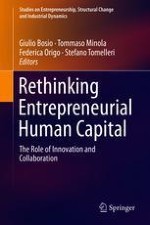2018 | OriginalPaper | Chapter
Mutual Gains? The Role for Employee Engagement in the Modern Workplace
Author : Alex Bryson
Published in: Rethinking Entrepreneurial Human Capital
Publisher: Springer International Publishing
Activate our intelligent search to find suitable subject content or patents.
Select sections of text to find matching patents with Artificial Intelligence. powered by
Select sections of text to find additional relevant content using AI-assisted search. powered by
